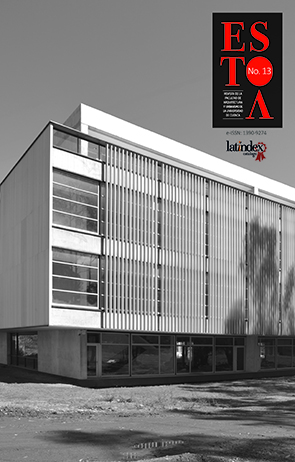Mitigation of residential densification in height. The case of Las Condes commune of Santiago de Chile
DOI:
https://doi.org/10.18537/est.v007.n013.a06Keywords:
island houses, densification in height, residencesAbstract
Residential densification in height is a territorial planning strategy designed to increase the use of the attributes of the urban space that mainly affects the consolidated territories. It is expressed through the change in the urban parameters altering the productivity and occupancy density, the building surfaces and the building height, conditions that together modify the urban landscape generating externalities that must be controlled. Otherwise they cause segregation and loss of identity, so that the inclusion of regulations aimed at mitigating impact is the most appropriate strategy for the installation of the measure. The analysis of the effect caused by the special regulations for residual properties caused by the fusion of soils installed in the Regulatory Plan of the Commune of Las Condes, one of the most important in the city of Santiago, allowed to evaluate the pertinence and to recommend the conditions of improvement and replicability.
Downloads
References
Cárdenas, L. A., higueras, E. (2015). El barrio solar: reflexiones y aplicaciones en doce ciudades iberoamericanas. España: Mairea Libros.
Cárdenas, L. A. y Uribe, P. (2012). Acceso solar a las edificaciones. El eslabón pendiente en la norma urbanística chilena sobre la actividad proyectual. Revista de Urbanismo, (26), 21-42.
Carrasco Pérez, G. (2015). Santiago Sur: Principales problemáticas, potencialidades y desafíos del sector sur. En Santiago Sur: formación y consolidación de la periferia (290-295). Santiago, Chile: I. M. de Santiago.
Chavoya Gama, J. I.; García Galván, J.; Rendón Contreras, H. J. (2009). Una reflexión sobre el modelo urbano: ciudad dispersa-ciudad compacta. En 5th International Conference Virtual City and Territory (pp. 37-50), Barcelona, España: Centre de Política de Sòl i Valoracions.
Dammert, L. (2004). ¿Ciudad sin ciudadanos? Fragmentación, segregación y temor en Santiago. EURE, Santiago, 30 (91), 87-96.
Evans, A. (2006). Externalidades, planificación y decisiones colectivas en Santiago, donde estamos hacia dónde vamos. CEP, Chile.
Gallardo, F. y Sahady, A. (2002). En edificios de ayer, funciones de hoy. La vivienda: una constante histórica. Revista INVI, 17(45), 69-81. Recuperado de http://www.revistainvi.uchile.cl/index.php/INVI/article/viewArticle/382
Greene, M. y Soler, F. (2004). Santiago: de un proceso acelerado de crecimiento a uno de transformaciones. C. de Mattos, et al. (eds.), Santiago en la globalización. ¿Una nueva ciudad? (47-84). Santiago, Chile: Ediciones Sur-Eure Libros.
Herrmann, G., & Van Klaveren, F. (2013). ¿Cómo densificar? Problemas y desafíos de las tipologías de densificación en la ciudad de Santiago. Revista 180. (31), 38-43. Recuperado de http://www.revista180.udp.cl/index.php/revista180/article/view/73/71
Hopfgartner, K., & Vidosa, R. (2014). Espacios exclusivos y excluyentes: ¿cómo y quién habita el espacio público? El boulevard Naciones Unidas (Quito) y La Boca (Buenos Aires). Gestión y Ambiente, 17(1), 21-37.
Lerner, J. (2014). Urban Acupunture. Washington, EE.UU.: Island Press.
Mardones, R. (2009). ¡No en mi patio trasero!: el caso de la comunidad ecológica de Peñalolén. Iconos. Revista de Ciencias Sociales. (34), 139-149.
Pallarés, M. E., Lou, J. Ch., Pallarés, M. (2015) Aporte de la normativa especial de predios existentes residuales de densificación a la consolidación del tejido urbano. En: XIX Congreso Arquisur: Ciudades vulnerables: Proyecto e incertidumbre. Universidad Nacional de La Plata. La Plata, Argentina.
Pallarés, M. (2015). La arquitectura religiosa en Santiago de Chile 1850-1950. Razones de las reminiscencias góticas. (Tesis doctoral), Universidad Politécnica de Madrid, Madrid, España.
Pallarés Torres, M.E., Pallarés, M., & Lou, J. Ch. (2017). Oportunidad para el desarrollo de terrenos islas en la comuna de Las Condes. Revista INVI, 32(89), 171-196.
Pigou, A. C. (2017). La economía del bienestar. Pamplona, España: Editorial Aranzadi,
Soto, N. & Hormazabal, R. (2009). Mi vecino apesta. Una aproximación sociológica al fenómeno de Lulu. Revista INVI. 24 (65), 139-176. Recuperado de http://www.revistainvi.uchile.cl/index.php/INVI/article/view/448
Seisdedos, G. (2007). Como gestionar las ciudades del siglo XXI. Madrid, España: Prentice-Hall.
Published
How to Cite
Issue
Section
License
The Journal declines any responsibility for possible conflicts derived from the authorship of the works that are published in it.
The University of Cuenca in Ecuador conserves the patrimonial rights (copyright) of the published works and will favor the reuse of the same ones, these can be: copy, use, diffuse, transmit and expose publicly.
Unless otherwise indicated, all contents of the electronic edition are distributed under a Creative Commons Attribution-NonCommercial-ShareAlike 4.0 International License.




